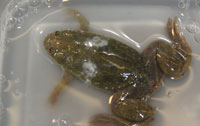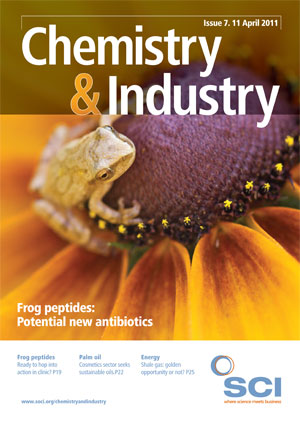The war between the human race and pathogenic microorganisms is relentless, with the balance of power constantly shifting. For all of human history, aside from war, famine and natural disasters, infectious diseases have been the leading cause of death especially among children. Regrettably, the past 20 years has seen a dramatic emergence of strains of bacteria and fungi with varying degrees of resistance to common antibiotics – a situation that poses a serious threat to public health. Inappropriate or excessive administration of antibiotics by physicians is the major culprit, while complacency in the pharmaceutical industry has meant that until recently very few new antibiotics were in production or being developed to meet this threat.

| Peptide | Frog Specises | Amino acid sequence |
| Angiotensin II | Red-legged froglet Crinia geogiana |
Ala-Pro-Gly-Asp-Arg-lle-Tyr-Val-His-Pro-Phe |
| Bombesin | Fire-bellied toad Bombina bombina |
pGlu-Gln-Arg-Leu-Gly-Asn-Gln-Trp-Ala-Val-Gly-His-Leu-Met-NH2 |
| Bradykinin | European common frog Rana temporaria |
Arg-Pro-Pro-Gly-Phe-Ser-Pro-Phe-Arg |
| Caerulein | White's Treefrog Litoria caerulea |
pGlu-Gln-Asp-Tyr(SO3)-Thr-Gly-Trp-Met-Asp-Phe.NH2 |
| Phyllomedusin | Giant monkey frog Phyllomedusa bicolor |
pGlu-Asn-Pro-Asn-Arg-Phe-lle-Gly-leu-Met-NH2 |
| Xenopsin | African Clawed frog Xenopus laevis |
pGlu-Gly-Lys-Arg-Pro-Trp-lle-Leu |
Although some effective new antibiotics against multidrug-resistant Gram-positive bacteria such as MRSA have been introduced or are currently in clinical trials, the situation regarding Gram-negative pathogens is less encouraging and there is an urgent need to develop completely new types of antimicrobial agents to which pathogenic microorganisms have not been exposed.
Peptide treasure trove
Venomous species of animals have long provided a source of inspiration for those interested in finding new drugs. However, the realisation that the skins of many frog species contain a bewildering array of peptides with diverse biological activities was down to the pioneering efforts of the Italian pharmacologist Vittorio Erspamer. From the 1940s almost until his death in 1999, Erspamer purified, characterised and determined the properties of a wide range of biogenic amines and peptides present in the skins of hundreds of frog species. These include many peptides that are active on smooth muscle, such as tachykinins, bradykinins, bombesins, caeruleins, xenopsins and angiotensins that are structurally, but not necessarily evolutionarily, related to peptides found in humans. These components, as well as other toxins in frog skin, may play a role in protecting the animal against ingestion by predators. Some examples of these defensive peptides are shown in Table 1.
| Frog species | Naturally occurring antimicrobial peptide |
Non-toxic lysine- subtituted analogue |
Microorganism targeted |
| Midwife toad Alytes obstetricans |
Alyteserin-1c | [Lys-4]alyteserin-1c | Multidrug-resistant Acinetobacter baumannii |
| Tailed frog Ascaphus | Ascaphin-8 | [Lys-18]ascaphin-8 | Extended-spectrum β-lactamase (ESBL) Klebsiella pneumoniae |
| Paradoxical Frog Pseudis paradoxa |
Pseudin-2 | [Lys-3,Lys-14]pseudin-2 | Antibiotic-resistant Escherichia coli |
| California red-legged frog Rana draytonii | Temporin-DRa | [Lys-7]temprin-DRa | Methicillin-resistant Staphylococcus aureus (MRSA) |
| Tropical clawed frog Silurana tropicalis |
XT-7 | [Lys-4]XT-7 | Methicillin-resistant Staphylococcus aureus (MRSA) |
For at least part of their life cycle, frogs and toads are of necessity confined to a warm and moist environment that is conducive to the growth of potentially harmful bacteria and fungi. It is not surprising, therefore, that they have evolved a system of host–defence that will protect the skin of the organism from invasion by pathogenic microorganisms. As well as lipid and mucus components, the secretions that continuously bathe the surface of the frog’s skin often contain very high concentrations of cell-penetrating peptides with growth inhibitory activity against bacterial and fungal pathogens that the animal will encounter.
These peptides constitute a component of the system of innate immunity that represents the first line of defence against invasion by such pathogens. The antimicrobial peptides are also active against microorganisms that have relevance to infections in humans and the medicinal folklore of many cultures, particularly in the East Asia, associates extracts of frog skin with the promotion of wound healing by preventing infection. Frog lovers will be pleased to learn that skin secretions may be obtained by a procedure – injection of the neurotransmitter noradrenaline – that does not appear to cause any distress and wild-caught animals are always released unharmed at the exact site of collection.
Frog skin antimicrobial peptides comprise between 10 and 48 amino acid residues and a comparison of their amino acid sequences reveals the lack of any conserved domains that are necessary for biological activity. However, with few exceptions, the peptides have a strong positive charge due to the presence of multiple lysine residues and they contain at least 50% hydrophobic amino acids, of which leucine and isoleucine are usually the most abundant. Circular dichroism and NMR studies have shown that they generally lack stable secondary structure in aqueous solutions but adopt an alpha-helical conformation in a solvent such as 50% trifluoroethanol/water that mimics the environment of the cell membrane. The conformation of the helix is amphipathic, meaning that the positively charged amino acids align on one face of the helix with the hydrophobic amino acids aligning on the opposite face.
There is no single mechanism by which the peptides produce cell death, but their action generally involves a non-specific binding to the bacterial cell membrane rather than interaction with a specific receptor. The peptides have the ability to insert themselves into the phospholipid bilayer of cell membranes, resulting in their disruption and eventual disintegration into peptide-coated vesicles.
Not all frogs produce antimicrobial peptides in their skin secretions and the species distribution of such peptides among the various frog families is sporadic. At this time, the vast majority of antimicrobial peptides – now numbering more than 1000 – have been purified from tree frogs from Central and South America and Australia belonging to the Hylidae family and from the socalled ‘true frogs’ from Eurasia and North America belonging to the Ranidae family. In general, a frog releases multiple peptides into its skin secretions each with a different potency and specificity for microorganisms thereby providing protection against a wide range of invading pathogens.
Advantages and disadvantages
On the positive side, existing multidrug-resistant pathogens will be susceptible to newly introduced peptide-based anti-infective agents and their nonspecific and highly destructive mode of action means that microorganisms are less likely to become resistant. Although development of resistance to antimicrobial peptides has been demonstrated in laboratory cultures following repeated exposure, it occurs at rates that are orders of magnitude lower than those observed for conventional antibiotics. Many frog skin peptides show broad spectrum antimicrobial activity with high potencies against both Gram-positive and Gram-negative bacteria and against opportunistic yeast pathogens, such as Candida albicans. The peptides are almost always bactericidal rather than bacteriostatic, causing cell death as opposed to preventing cell growth, and act rapidly.
On the negative side, large scale synthesis of peptides, either chemically or using recombinant DNA technology, and their purification to pharmaceutical industry standards is laborious and expensive. The naturally occurring frog skin peptides, as well as displaying broad-spectrum antimicrobial activities, are to varying degrees toxic to human cells. For example, they will produce haemolysis of red blood cells by permeabilising the erythrocyte plasma membrane, generally at appreciably higher concentrations than those that produce bacterial cell death. A further obstacle to the development of peptide-based antiinfectives, particularly if they are to be administered systemically, is their short half-lives in the circulation. However, peptides applied to infected skin or skin lesions in the form of sprays or ointments can penetrate into the stratum corneum – the outermost layer of the epidermis – to kill microorganisms so that future therapeutic applications are more likely to involve topical rather than systemic administration.
Valuable anti-infective agents
The antimicrobial activities of a frog skin peptide against bacteria and fungi and its toxicity towards human cells are determined by several factors, including the magnitude of its molecular charge, the distribution of the charge over the peptide surface, the degree of hydrophobicity and conformational stability. The bacterial cytoplasmic cell membrane is rich in negatively charged phospholipids and lipopolysaccharides, whereas the plasma membrane of mammalian cells contains a much higher proportion of ‘zwitterionic’ phospholipids – comprising equal numbers of positive and negative charges – together with uncharged cholesterol and cholesterol esters. An increase in the positive charge on the antimicrobial peptide should, in principle, promote interaction with the more negatively charged bacterial cell membrane and increase antimicrobial potency without increasing toxicity against human cells.
This strategy has been found to work in practice and has led to the design of analogues of several naturally occurring frog skin peptides with significantly higher antimicrobial potencies but reduced toxicities against human cells, such as blood cells and fibroblast cells that give rise to connective tissue. Peptides with improved therapeutic properties are prepared by substituting appropriate acidic or neutral amino acids on the hydrophilic face of the alpha-helix by the strongly basic amino acid L-lysine.
In the examples in Table 2, the frogs have been obtained from diverse locations: the midwife toad from Switzerland; the tailed frog and the red-legged frog from California; the lab-bred paradoxical frog, so called because it ‘grows down’ from a large tadpole to a small frog, originally from Columbia; and the tropical clawed frog originally from Senegal. The peptides will generally inhibit the growth of the targeted antibiotic-resistant bacteria at concentrations less than 10microM but do not produce detectable haemolysis of red blood cells at concentrations less than 200microM. These antimicrobial potencies are comparable in molar terms with those of most standard antibiotics currently in use.
Therapeutic potential
Over 20 years have passed since the identification of the magainins in the skin of African clawed frog, Xenopus laevis. These were the first amphibian peptides with antimicrobial activity to be fully characterised, identified independently by Michael Zasloff at the National Institutes of Health, Bethesda, US, and by the group of Dudley H. Williams at the University of Cambridge, UK. Since that time around 1000 peptides have been isolated from the skin secretions of frogs belonging to different families. However, despite showing broad-spectrum activity against strains of antibiotic-resistant bacteria and against certain pathogenic fungi and protozoa, no anti-infective peptide based upon their structures has been adopted in clinical practice. The lysinecontaining analogue of magainin, pexiganan acetate (MSI-78), showed distinct promise as a topical anti-infective agent for the treatment of infected foot ulcers in diabetic patients and as a possible treatment for impetigo. However, the US Food and Drug Administration did not approve marketing of this agent on the grounds that efficacy has not been sufficiently demonstrated.
For progress in the field to continue, new clinical applications need to be found. In my own laboratory in the United Arab Emirates University, for example, researchers have recently identified a number of non-toxic analogues of frog skin peptides with the potential for exercising a dual role in treatment of the common skin condition acne vulgaris, by targeting both the infection and inflammation. As well as causing cell death of the major infective agent, the Gram-positive anaerobic bacillus Propionibacterium acnes at low concentrations, the peptides inhibit the release of proinflammatory cytokines and so may reduce the inflammatory response that follows bacterial skin colonisation.
In terms of their potential for combating superbugs, meanwhile, frog skin antimicrobial peptides, or any other therapeutic agent, would not mean the elimination of ‘superbugs’ by themselves. Undoubtedly, strains of pathogenic bacteria will eventually develop resistance by altering the phospholipid composition of cell membranes to reduce binding of the peptides and will express proteolytic enzymes that will degrade them. The war will continue, but frog skin peptides may buy the human race some time while yet ever newer types of antimicrobial agents are developed.
J. Michael Conlon is professor and chair in the department of biochemistry at United Arab Emirates University, UAE.





